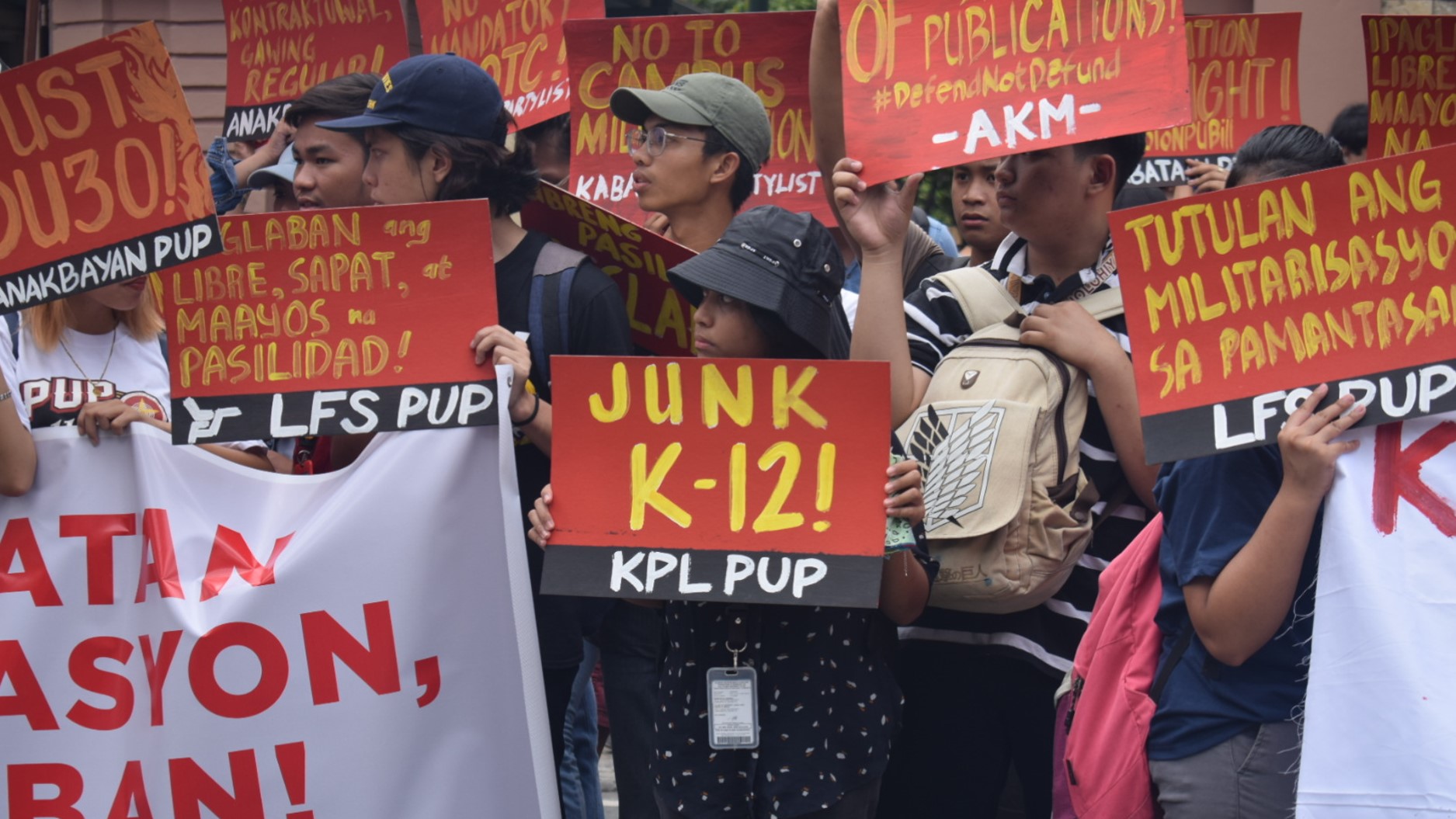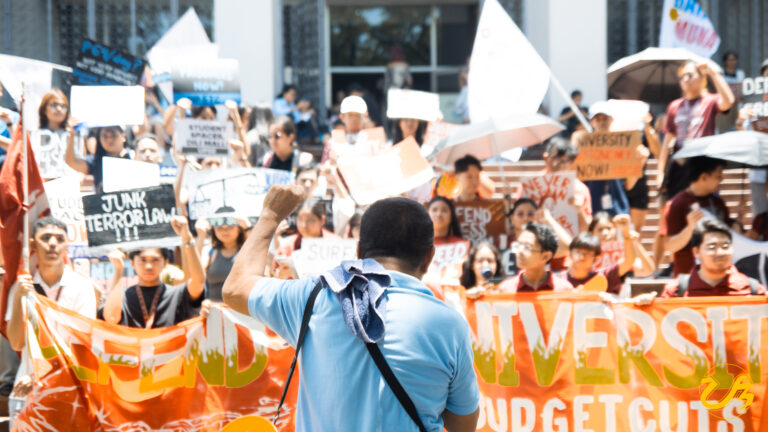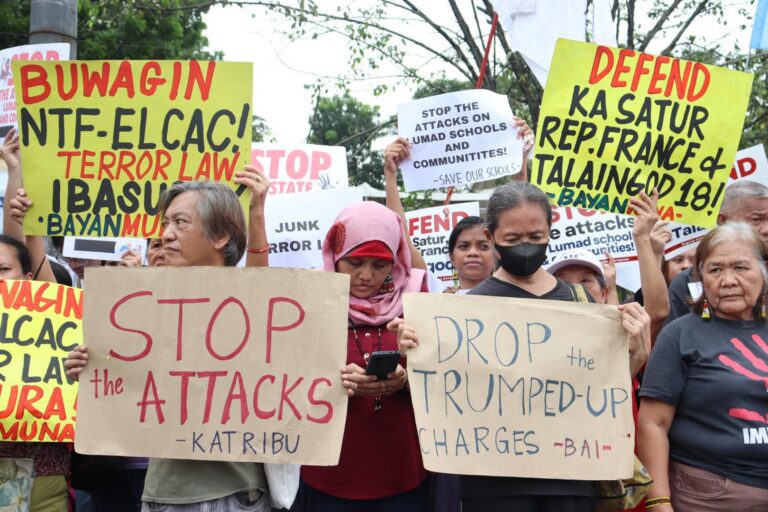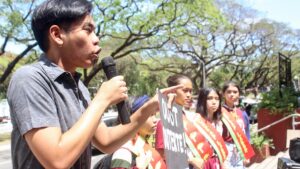
The K-12 program was implemented in 2013, producing two batches who have graduated Senior High School (SHS) since its inception in 2016. Yet, students are still decrying anomalies in the program, some of which are the lack of facilities, materials, and teachers, high cost of education, and confusing curricula. This led the Kabataan Partylist to push for its review in Congress.
Consequently, the K-12 program has been a topic of heated discussions especially during University of the Philippines (UP) Political Society’s Aktibisita 2020: A Roundtable Discussion on the Ideological Position of Political Parties in UP Diliman last March 4.
Many K-12 graduates expressed their disappointment in social media when UP ALYANSA and KAISA UP, two of UP Diliman’s political parties, said “yes“ to the K-12 program. The parties were then questioned on their initiatives to consult K-12 graduates.
Prior to this year’s Akitibista, the College of Social Sciences and Philosophy Freshie Council (CSSP FC) and the College of Arts and Letters Freshies, Shiftees, and Transferees Council (CAL FSTC), in partnership with Rise for Education (R4E) Alliance and other freshie councils, held a constituent meet and consultation on the criticized state of the K-12 program. The consultation was held last February 21 and was attended by UP Diliman freshmen and transferees.
According to the organizers, the findings of the consultation will be submitted to the congressional committee that will handle the review of the K-12 program.
UNPREPARED
The responses from the consultation highlighted the unpreparedness on the implementation of the K-12 program. SHS graduates cited the lack of classrooms, laboratories, rehearsal spaces, and materials provided solely for them.
“Parang nakikipag-agawan kami sa mga college students sa mga laboratory namin,” (It’s like we were fighting over laboratories with college students.) one cited. Another manifested that their SHS building was originally an infrastructure for the elementary students.
“Alam niyo ba kung saan pinapunta yung faculty? Sa CR. Sa CR sila nag-faculty and walang ventilation ‘yung faculty namin,” (Do you know where the faculty went? At the CR. It’s where their offices were and there’s even no ventilation there.) he added, pertaining to Los Baños Senior High School.
The situation of the teaching and non-teaching staff was also discussed. One cited the lack of expertise within the teachers that was, according to the K-12 graduates, brought upon by the lack of training and seminars for SHS teachers. Another said that their guidance counselor had to handle more than 900 students.
“Maraming guro maging sa public school man o sa private ay nagtuturo na ng hindi nila inaral. May mga nagtuturo ng dalawang subject, may mga nagtuturo ng more than ten classes,” (Many teachers, whether in public schools or in private, are already teaching matters they haven’t studied yet. There are those who teach two subjects, there are those who teach more than ten classes) John, a K-12 graduate, said.
These burdens were said to be handed to the teaching staff despite the government’s refusal to increase their salary. Additionally, problems regarding the curriculum were cited. Mary from the second batch of SHS said,
“We felt like while the academic year was going, [the school was] implementing new stuff in the middle para sinisiksik nila sa curriculum… Parang trial and error lang ‘yung batch namin.” (We felt like while the academic year was going, [the school was] implementing new stuff in the middle just to cram them in the curriculum… Our batch was just like trial and error.)
“PAHIRAP”
The K-12 program requires students to take two additional years to earn a high school diploma, thus imploring them to shell out more money to pay for tuition and other school fees.
Many decried the high tuition fees in private schools that did not provide them with enough facilities and instead imposed a “confusing” curriculum. Graduates from both public and private schools also voiced out against having to wear uniforms that cost up to P2,000 per set.
Moreover, they lamented about having to spend thousands of pesos over academic requirements.
“It was a lot harder for my parents to earn, their sweldo is the same pero the tuition is tumaas. I’d say it’s very unfair,” Mary* said. (It was a lot harder for my parents to earn, their income is the same pero the tuition is increasing. I’d say it’s very unfair)
The voucher system that acts as the government’s subsidy to students who will pursue SHS in private schools was also questioned as it was deemed discriminatory. According to the Department of Education (DepEd), vouchers amount from P8,750 to P22,500, as compared to a private school tuition fee amounting to a hundred thousand pesos.
Yet according to Sam, a graduate from a private school, some schools prioritize those with the smaller voucher amount. “Porke ba wala silang binabayad, wala silang textbooks o wala silang libro… tapos sila din yung walang classrooms. Kaya ang unfair na ganoon ang trato sa mga matataas ang voucher sa amin,” (Just because they don’t pay anything, they can’t have textbooks nor regular books… they’re also the ones who don’t have classrooms. That’s why it’s unfair that the treatment was like that for those who have higher vouchers than us.) he added.
Moreover, many K-12 graduates do not see the use of the two additional years in basic education. They cite the lack of specialization of teachers, repetition of subjects in college, and faulty implementation of the program as factors as to why SHS was a “waste of time.’ “We felt that [SHS] is rushed and a very confusing two years for me,” Mary said.
COLONIAL CHARACTER
According to DepEd, K-12 will help its graduates become more competitive in the global scene. However, several graduates say that K-12 is just a scheme to export cheap labor to more powerful countries, thus causing brain drain.
“Kumbaga, tayong mga produkto ng K-12 ay ieexport sa ibang bansa upang matugunan ang kanilang pangangailangan. Nandoon pa rin yung ideya na hindi pa rin tayo malayang bansa dahil hawak pa rin nila tayo,” Vince, (It’s like we, as products of K-12, are to be exported to foreign countries just so they could sustain their needs. The idea is still there, that we aren’t exactly decolonized because they still have us in their grasps.) another K-12 graduate, said.
Additionally, graduates have negated DepEd’s long standing promise of employment to K-12 graduates. According to Jobstreet.com’s 2018 Fresh Graduate Report released by Rappler in the same year, only one out of five employers are willing to hire K-12 graduates. Hence, the real motive of K-12 is to export its graduates who will not be able to pursue tertiary education.
“Sinong kumpanya ang tatanggap ng high school “lang” kung ang kakumpitensya ay college graduate? … Nandoon yung ilusyon na makakakuha ka ng magandang trabaho pagkatapos ng Senior High,” (What company would accept high school graduates over college graduates? There’s the illusion that you will be able to get a great job after Senior High.) Jam, another K-12 graduate, said.
ALTERNATIVE
Concluding their narratives, the interviewed K-12 graduates have initially agreed to short-term solutions for the program. These include holding seminars and training for teachers, and focusing on the quality of education.
For the long-term solutions, the graduates vouched for a scientific type of education that was actualized according to the material conditions of the country. They manifested that there should be lessons that cater to the development inside the country, as opposed to the export orientation of the K-12 program.
Additionally, the graduates also agreed that, contrary to K-12’s “colonial character,” a nationalist type of education that answers directly to the needs of the country should be implemented.
The discussion from the consultation registered the overwhelmingly negative impact of the K-12 program. With this, the organizers of the consultation expressed their dismay on the position of UP ALYANSA and KAISA UP regarding K-12.
“Batay sa kanilang mga sagot kung bakit sila sumusuporta sa pagpapatuloy ng K-12, dahil mayroon naman umano itong idinulot, nais natin silang tanungin, nasaan ang kaunlarang inanak ng K-12? Makailang ulit itong dinalumat at ibinatay sa konteksto ng edukasyon sa bansa. Ang kanilang mga naging sagot ay taliwas sa katotohanan, kung kaya ito ay patunay na hugot sa hangin ang kanilang suri [at] hindi sa aktwal na danas. Marapat na ibasura ang K-12 at sa halip, tugunan ng gobyerno ang kakulangan sa pasilidad, sahod ng mga guro, at makabayang kurikulum na kumikilala sa kalagayan ng bansa at naghahangad ng pagbabago para dito,” CSSP FC Linguistics Representative Jaie Ramirez said.
(Based on their answers as to why they support the continuation of K-12, because it allegedly had fruitful effects, we would like to ask them, where is the progress that K-12 bore? Countless times have this been researched and based on the context of education in the country. Their answers are far from the truth, which is why this is proof that their analyses are nonexistent [and] not based on actual experiences. K-12 should be junked instead, the government should provide for the lack of facilities, teachers’ wage, and nationalistic curriculum that recognizes the state of the nation and hopes for its development.)
Ultimately, the freshies, shiftees, and transferees councils in UP Diliman call for the junking of the K-12 program.
“Dapat ibasura ang K to 12. [I]sinusulong ng papel na ito ang transisyon patungo sa isang sistemang pang-edukasyon na nakabatay sa pansariling pangangailangan ng bansa. Ang edukasyong ito ay tutuon sa mga pangarap at hangarin ng kaestudyantehang Pilipino, lagpas sa pagturing sa kanila bilang mga manggagawa ng dayuhan,” as said in the UP Freshies, Shiftees, and Transferees Councils Position Paper on K to 12.
(K-12 must be junked. This paper forwards the transition towards an education system based on the distinctive needs of the country. This education shall focus on the dreams and aspirations of the Philippine studenty, far beyond their treatment as laborers to foreigners.)
*Pseudonyms were used for the safety of the interviewees.
This article was initially published as part of the mini-SINAG issue in the publication’s January 2020 issue.








I can’t wait to implement some of these ideas. I enjoyed reading this and learned something new. Thanks for taking the time to put this together! This blogpost answered a lot of questions I had. The content in this blog is truly eye-opening. Thanks for taking the time to put this together! Fantastic job covering this topic in such depth!